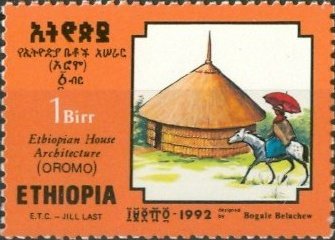Stamp: Ethopian House Architecture: Oromo (Ethiopia 1992)
Ethopian House Architecture: Oromo (Ethiopia 1992)
14 May (Ethiopia ) within release Traditional homes goes into circulation Stamp Ethopian House Architecture: Oromo face value 1 Ethiopian birr
| Stamp Ethopian House Architecture: Oromo in catalogues | |
|---|---|
| Michel: | Mi:ET 1416 |
| Stamp Number: | Sn:ET 1334 |
Stamp is square format.
Also in the issue Traditional homes:
- Stamp - Ethopian House Architecture: Afar face value 15;
- Stamp - Ethopian House Architecture: Anuak face value 35;
- Stamp - Ethopian House Architecture: Gimira face value 50;
- Stamp - Ethopian House Architecture: Oromo face value 1;
|
Data entry completed
50%
|
|
|---|---|
| Stamp Ethopian House Architecture: Oromo in digits | |
| Country: | Ethiopia |
| Date: | 1992-05-14 |
| Print: | Unknown |
| Emission: | Commemorative |
| Format: | Stamp |
| Face Value: | 1 Ethiopian birr |
Stamp Ethopian House Architecture: Oromo it reflects the thematic directions:
Architecture (Latin architectura, from the Greek ἀρχιτέκτων arkhitekton "architect", from ἀρχι- "chief" and τέκτων "builder") is both the process and the product of planning, designing, and constructing buildings and other physical structures. Architectural works, in the material form of buildings, are often perceived as cultural symbols and as works of art. Historical civilizations are often identified with their surviving architectural achievements.
The horse (Equus ferus caballus) is one of two extant subspecies of Equus ferus. It is an odd-toed ungulate mammal belonging to the taxonomic family Equidae. The horse has evolved over the past 45 to 55 million years from a small multi-toed creature, Eohippus, into the large, single-toed animal of today. Humans began to domesticate horses around 4000 BC, and their domestication is believed to have been widespread by 3000 BC. Horses in the subspecies caballus are domesticated, although some domesticated populations live in the wild as feral horses. These feral populations are not true wild horses, as this term is used to describe horses that have never been domesticated, such as the endangered Przewalski's horse, a separate subspecies, and the only remaining true wild horse. There is an extensive, specialized vocabulary used to describe equine-related concepts, covering everything from anatomy to life stages, size, colors, markings, breeds, locomotion, and behavior.
A house is a single-unit residential building. It may range in complexity from a rudimentary hut to a complex structure of wood, masonry, concrete or other material, outfitted with plumbing, electrical, and heating, ventilation, and air conditioning systems. Houses use a range of different roofing systems to keep precipitation such as rain from getting into the dwelling space. Houses generally have doors or locks to secure the dwelling space and protect its inhabitants and contents from burglars or other trespassers. Most conventional modern houses in Western cultures will contain one or more bedrooms and bathrooms, a kitchen or cooking area, and a living room. A house may have a separate dining room, or the eating area may be integrated into the kitchen or another room. Some large houses in North America have a recreation room. In traditional agriculture-oriented societies, domestic animals such as chickens or larger livestock (like cattle) may share part of the house with humans.
A tradition is a system of beliefs or behaviors (folk custom) passed down within a group of people or society with symbolic meaning or special significance with origins in the past. A component of cultural expressions and folklore, common examples include holidays or impractical but socially meaningful clothes (like lawyers' wigs or military officers' spurs), but the idea has also been applied to social norms and behaviors such as greetings, etc. Traditions can persist and evolve for thousands of years— the word tradition itself derives from the Latin word tradere literally meaning to transmit, to hand over, to give for safekeeping. While it is reportedly assumed that traditions have an ancient history, many traditions have been invented on purpose, whether it be political or cultural, over short periods of time. Various academic disciplines also use the word in a variety of ways.
An umbrella or parasol is a folding canopy supported by wooden or metal ribs that is mounted on a wooden, metal, or plastic pole. It is usually designed to protect a person against rain. The term umbrella is traditionally used when protecting oneself from rain, while parasol is used when protecting oneself from sunlight, though the terms continue to be used interchangeably. Often the difference is the material used for the canopy; some parasols are not waterproof, and some umbrellas are transparent. Umbrella canopies may be made of fabric or flexible plastic. There are also combinations of parasol and umbrella that are called en-tout-cas (French for "in any case").





